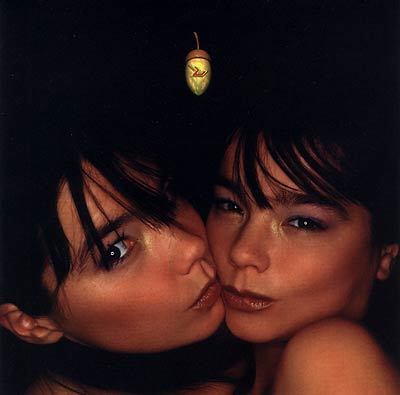When Travis covered …Baby One More Time as tender British comfort rock, it was cute.
[audio:070715BabyOneMoreTime.mp3]When Jonathan Coultan did Baby Got Back as a singer/songwriter folk troubadour, it was funny.When The Gourds played Gin n’ Juice in up-the-mountain bluegrass style, it was just bizarre.
Play:
When Mat Weddle of Obadiah Parker re-invented Hey Ya! as a somber, heartfelt ballad, it was endearing.
Then there was Alanis, whose performance of My Humps showed sublime brilliance.
But this, this is just getting out of hand: Jenny Owen Youngs playing Nelly’s Hot in Herre:
I don’t mean to call out Ms. Youngs in particular, but hearing her play Nelly has got me thinking: seriously, what is going on here? What is up with this string of rock-mode artists covering hip hop/pop songs?
And conversely, why don’t we see the same thing in reverse: Contemporary hip hop artists covering rock songs? That might just be cultural differences; rockers cover, rappers sample.
One could argue that a great song is a great song and that successful reinterpretations reflect well on the source material. But I won’t be the one making that argument because, looking over that list of songs, I can’t help but notice that most of those inspiration points are of dubious artistic merit.
While Outkast gets props for artistry, Britney Spears is generally not regarded for the quality of her music. And I like Gin n’ Juice as much as the next guy (5 stars in my iTunes library), but it’s not what I would call “great music.” So, what is it about that song, or …Baby One More Time, or Hot in Herre that makes them attractive targets for rock-based musicians to cover?
Generally, to cover a song is a choice to pay tribute to it or its originator, a way to honor them for their influence and their impact on the development of the person performing the cover. Witness Beatles tribute bands, KISS tribute bands and Elvis impersonators. Shoot, Radiohead has created a cottage industry of cover artists and performers.
But, one does not create a bluegrass version of
One possible explanation is that it’s been nearly a decade since vapid pop and profligate ego-rap began to dominate corporate music culture. Bad music is what the young folks are used to hearing en masse, so it makes some sense that the current generation’s crop of young musicians would play what they are familiar with. I know that when I was younger and in a band, a good part of our repertoire consisted of the contemporary hits of the time.
But we were a rock band playing rock songs. And it was heyday of grunge and its aftermath, where the ethos explicitly called for the rejection of corporate music. The irony of course, is that by the time grunge had become big enough to be called a movement, most of its artists had moved to corporate labels.
Still, those artists didn’t make names for themselves by playing the hits of their predecessors. Nirvana didn’t become famous by playing Rock You Like A Hurricane and Every Rose Has Its Thorn in the clubs of Olympia. Even at the apex of the irony-soaked 90s, one was more likely to see bands covering influential songs from the 60s and 70s rather than perform joking versions of songs by discredited 80s acts. The audience would not have stood for it.
And that’s the other part of this equation: the listeners. Modern audiences seem to LOVE these homages to the silly and ridiculous. Alanis’ My Humps made a huge splash on the net (7.9 million views on YouTube as of this writing). Jonathan Coulton owes a good portion of his stature to his remake of Baby Got Back.
But therein lies a double-edged sword. For established artists, the choice to release an unconventional cover can be a fun diversion for the fan base. But for new and emerging artists, taking a shortcut by means of using someone else’s song to attract attention threatens to forever pigeonhole that artist into the novelty camp.
Mr. Coulton, no matter his other merits, may forever be the folksy-Baby-Got-Back guy. The Gourds, despite their long history, might never outgrow their notoriety as hillbilly gangsters smokin’ indo.
And that’s when it works! There’s always the possibility that the new version might somehow be catastrophically wrong. The above Ms. Youngs cover is my first exposure to her work and from this point forward, she will probably be known to me as the purveyor of a completely unnecessary endeavor.
Why would a new musician take the risk for what is surely an unpredictable response? For the joke of it? Irony? Camp value? Plain harmless mirth? Sure, absurd cover versions might be fun for a while, but like candy, too much will make you sick.
I suspect a large part of the explanation for the phenomenon lies with ever-expanding democratization of the means of production. Until fairly recently, the barrier to entry was significantly high for the recording and distribution of music. In addition to musicianship, one needed to own relatively expensive equipment (mics, amps, multi-track recorders, etc.) and have the knowledge to use them, or one needed to have access to expensive professional studio time. Of course, there was the time and patience needed to get it all put together. And that was just to get the recording made. As recently as ten years ago, getting that recording into the ears of others meant a hefty investment in cassettes and authored CDs from a duplication house.
With so much time and energy involved, musicians, particularly low-resource ones, would surely try to avoid being frivolous with their efforts. Care and consideration of the material were required to make maximum use of scarce commodities.
However, with the aid of technology (inexpensive computers, video cameras, audio recorders and programs like Apple’s Garageband, etc), the process of proficiently recording music is much more manageable and far less time consuming. High-speed Internet makes that music instantly available to a billion people. It can easily seem like a lark to throw together any ol’ ditty based on a whim, including songs that have only recently been released.
In fact, I would not be surprised if that were to become a new trend, the near-immediate release of covers of new songs. Indeed, such an occurrence has already happened. Franz Ferdinand’s version LCD Soundsystem’s All My Friends was released as an official b-side on the All My Friends single. It’s not so far fetched to imagine that Britney’s next single will get a folk treatment on YouTube within days of its release.
Why anyone would do that is beyond me, but it is a distinct possibility.



